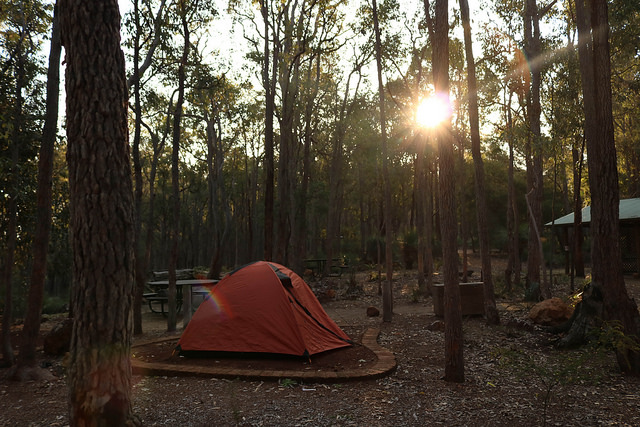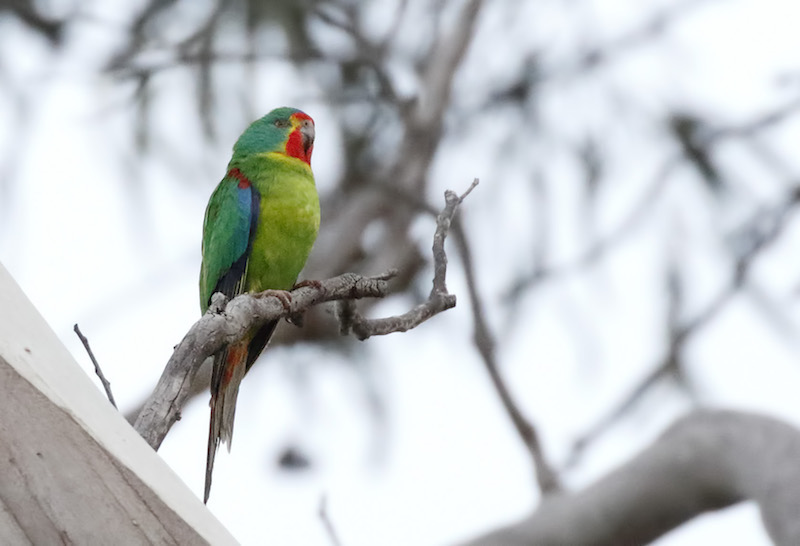“We’re worried that we’re going to see the extinction of [the Swift Parrot] within our careers—before the end of them” 1
 Last November, Prime Minister Morrison signed up for extinction. He put his name to the Regional Forest Agreements (RFAs) through which the Commonwealth devolves environmental responsibility to the states and washes its hands of the outcome. Unless overturned by a court or a future government, native forest logging in NSW will remain exempt from Commonwealth environmental laws until at least 2039, even as species like the Swift Parrot, Greater Glider and Koala are pushed to the brink.
Last November, Prime Minister Morrison signed up for extinction. He put his name to the Regional Forest Agreements (RFAs) through which the Commonwealth devolves environmental responsibility to the states and washes its hands of the outcome. Unless overturned by a court or a future government, native forest logging in NSW will remain exempt from Commonwealth environmental laws until at least 2039, even as species like the Swift Parrot, Greater Glider and Koala are pushed to the brink.
How do we know that species are heading for extinction? Because the Commonwealth’s Threatened Species Scientific Committee has identified logging in one form or another as a threat to more than 60 animals on the government’s own list of vulnerable, endangered and critically endangered species. The direction of change for these species is inexorably worse as more are added to the list and those already on it are moved to higher threat categories.
A string of court cases, reports by scientists, conservationists and community groups, and testimony such as is being given to the Senate Inquiry into the Faunal Extinction Crisis all tell the same story. Things need to change now if there’s to be any hope for our forests and wildlife.
It’s not as if the reasons for the march toward extinction are mysterious. As the Committee of Inquiry into the National Estate observed in 1974: “the closer preservation control comes to the local level, the more sectional interests may affect preservation issues”.2
Paul Keating made a similar point in 1991:
[There is a] line beyond which the pursuit of cooperative federalism becomes a surrender of powers which the efforts of generations of political leaders and jurists have conferred on the Commonwealth.
It is the line beyond which the Commonwealth trades the powers it can exercise for the well being of all Australians, merely for a reduction in the Federal noise level.3
Subsequently, as PM, the noise of the 1995 parliament house logging blockade persuaded him to surrender the Commonwealth’s power to protect native forests. The RFAs he introduced and John Howard negotiated have produced outcomes for native forests that were predictable and predicted.
The RFA mechanism accredits state forest management processes and exempts native forest logging carried out ‘in accordance with’ an RFA from the federal Environment Protection and Biodiversity Conservation Act. In this way the Commonwealth has chosen to render itself largely powerless to enforce RFAs even where the States’ actions or lack of action are impacting matters of national environmental significance, notably threatened species.
The RFA states — NSW, Victoria, Tasmania and WA — have adopted similar governance arrangements for native forest logging. They put industry-oriented agencies in the box seat, privilege production over protection and disempower the public. NSW has abolished third party rights to challenge alleged breaches of RFAs or logging rules. Several states are adopting draconian sanctions against protesters – in Tasmania the Lapoinya case ended up in the High Court with a win for Bob Brown and Jessica Hoyt.
The states’ governance arrangements for ‘multiple use’ native forests are framed around wood production. The key players are the state-owned logging agencies, the regulators and the processing companies. The constraints are, on one side wood volumes, legislated in Victoria and Tasmania, and on the other side logging rules.
 The logging agencies are commercially-focused (though often in practice loss-making) managers of wood production in public native forests and sometimes plantations on public land. They are accountable to economic ministers — the treasurer or ministers for finance, resources, forestry or agriculture. They act essentially as industry agents supplying log volumes specified in legislation or contracts. Their duty to the environment or other forest values is weak at best.
The logging agencies are commercially-focused (though often in practice loss-making) managers of wood production in public native forests and sometimes plantations on public land. They are accountable to economic ministers — the treasurer or ministers for finance, resources, forestry or agriculture. They act essentially as industry agents supplying log volumes specified in legislation or contracts. Their duty to the environment or other forest values is weak at best.
The logging agencies’ wood production volumes are set at levels supposedly able to be sustained in the long term without environmental detriment. The agency itself determines or is heavily involved in defining the so-called ‘sustained’ or ‘sustainable’ yield. This chimeric quantity is usually calculated for ‘sawlogs’ and depends not only on physical forest attributes, but also on the agency’s commercial wood supply objectives and economic and physical constraints. Log categories, such as pulplogs and firewood, are treated as by-products even though their volumes in regions such as Eden (southern NSW) dwarf sawlog volumes and they are often more important economically to the agency.
Rules, prescriptions or, in WA, guidelines govern how logging and other forest operations are supposed to be carried out. The logging agencies have a strong say in writing them and their purpose is variously expressed as: to ‘streamline’ the regulatory framework, provide certainty for industry, provide practical standards for timber harvesting. In NSW the Forestry Corporation effectively co-wrote with the EPA the new logging laws that have resulted in dramatically intensified logging. In WA the guidelines are weak, specifically described as ‘not prescriptive’ and unenforceable.
Regulators have been found wanting, not least by the recent royal commissions into banking and the Murray-Darling Basin. Native forest logging is no different. The regulators are timid, prefer to work cooperatively with industry and lack resources. Prosecutions are rare even for gross breaches and fines are derisory. In recent years, the NSW EPA launched three prosecutions for logging rocky outcrops. It won one, lost one and withdrew the third. In the successful case, FCNSW was fined $8000 . In 2018, the Victorian department (DELWP) launched only its second-ever prosecution against VicForests for logging rainforest in East Gippsland; the charge was found to be invalid and the case dismissed.
The final piece in the jigsaw is the group of large companies still processing native forest wood. There are not many and each broadly dominates a region. These companies have close relationships with their state logging agency, often at the expense of small operators. They usually have long term wood supply contracts adding another layer to the strength of the wood production ethos against conservation in forest management.
Commercially-focused state-owned logging agencies supplying legislated or contracted wood volumes to dominant companies under lax rules overseen by weak regulators does not sound like a recipe for looking after forests, wildlife, water or climate. It isn’t.
The Commonwealth surrendered its control of native forest logging 20 years ago. Even where it has both a responsibility and an opportunity to make a difference it does not. Recovery plans are supposed to set out the actions needed to prevent extinction of threatened species. If they impinge on logging, conservation paralysis sets in. The Swift Parrot recovery plan should have been updated in 2016 to take account of new threats; instead logging continues unabated in its Tasmanian breeding habitat. Leadbeater’s Possum remains without a recovery plan three years after it was identified as requiring emergency action. The Greater Glider will have been waiting three years this May, and the Koala a staggering nine years since its vulnerable listing in 2010.
The one moment when the Commonwealth unambiguously has the power to take back control of native forests is when RFAs expire but under Prime Ministers Turnbull (for Tasmania) and Morrison (for NSW) it has chosen not to. Even when the disastrous consequences for biodiversity are clear the Commonwealth is holding fast to the deeply flawed RFA arrangements. Its reasoning is Sir Humphrey at his best.
The regional forest agreements put in place support for ecologically sustainable forest management by the state agency …. [logging] practices are assessed on whether or not they will be consistent with ecologically sustainable forest management principles. If they are, they will be supported under the agreement.4 [emphasis added]
Or again
The RFAs were effectively an assessment and approval process. The large part of that assessment happened 20 years ago, with significant offsets for the assessment of values. Since then, we’ve been working in an adaptive framework with the state agencies to adapt, as new information becomes available on species, and amendments might be made in terms of prescriptions.5
In other words, we have principles and processes, let’s not be confused by facts.
Despite doubts about their legal validity the Commonwealth has signed 20 year RFA extensions with Coalition governments in Tasmania and NSW. RFAs in the Labor-held states of WA and Victoria expire in May 2019 and March 2020 respectively but both are working towards similar extensions under the rubric of ‘modernisation’.
 However bad things are now for forests and their wildlife, they will be infinitely worse as climate change takes hold. More extreme weather, more fires, increased frequency and severity of droughts will all take their toll on both nature and wood supply. Already this year fire has destroyed some of the scarce remaining Swift Parrot breeding habitat in southern Tasmania.
However bad things are now for forests and their wildlife, they will be infinitely worse as climate change takes hold. More extreme weather, more fires, increased frequency and severity of droughts will all take their toll on both nature and wood supply. Already this year fire has destroyed some of the scarce remaining Swift Parrot breeding habitat in southern Tasmania.
The original RFAs ignored climate change both as contributing to extinction risk and in terms of the vital role forests play in storing carbon and limiting global warming. The extended RFAs in Tasmania and NSW show nothing will change. In another nod to Sir Humphrey the parties to the Tasmanian RFA
acknowledge the need to manage Forests so as to maintain or enhance the contribution of managed Forests to the effective management of carbon within the carbon cycle;6
The wood products industry for which this system was designed has split. Most companies have voted with their feet and moved across to relatively uncontroversial plantations which today provide 88% of the wood harvested in Australia.
The companies still logging native forests are a different story. Protected by RFAs, they are hiding behind the tattered reputations of state logging agencies to claim that their wood supply comes from ‘sustainably managed forests’. Claims of sustainability feature strongly on their websites but not one makes the link between the wood they are selling and the cost borne by the forests and wildlife they exploit. These companies are complicit in extinction.
Bunnings and Officeworks last year realized the reputational risk of selling products from Victoria’s native forests, both wood and Reflex office paper. They committed to only selling Forest Stewardship Certified (FSC) timber from 2020 in Victoria and VicForests continues to pursue certification, strongly opposed by conservation groups and so far without success. Bunnings remains silent on selling wood from Koala habitat in NSW.
Community support for native forest logging has evaporated. Protests in the courts, the forests and the parliaments are rising.
We know, and the government knows, that if RFAs continue, a cascade of extinctions amongst forest-dependent wildlife will follow. We will not be able to plead ignorance.
To paraphrase Barack Obama, we are the first generation to witness the onset of mass extinction and the last that can do something about it. ‘Doing something about it’, in the Australian context, means reversing the Commonwealth government’s refusal to accept responsibility for our natural environment, ending the RFA debacle and building the institutions, the culture and the capability to look after forests, wildlife and natural ecosystems on a continental scale. It means major new funding and new laws. It means a central role for Indigenous people in a new era of restoration and renewal for our precious natural environment.
That’s a challenging — but exciting — prospect.
References
1.) Dr Matt Webb, Senate Inquiry into the Faunal Extinction Crisis, February 2019 3
2.) Report of the Committee of Inquiry into the National Estate, 1974, p.274 4
3.) Hon. P. J. Keating, The Commonwealth and the States and the November Special Premiers’ Conference, Address to the National Press Club, 22 October 1991. Quoted in Judith Ajani, 2007, The Forest Wars, p.174
4.) Senate Environment and Communications Legislation Committee, Estimates 22 October 2018. Mr Dadswell answering questions from Senator Rice. Hansard
5.) Ibid
6.) Tasmanian RFA as amended in August 2017
Feature Image Source: Swift Parrot_15-11-02_Lathamus discolor by Dave Curtis on Flickr.
State by state overview
The 2013 One Stop Chop report remains an excellent overview of the status and effect of Regional Forest Agreements, state by state.
NSW
Agency The state-owned Forestry Corporation (FCNSW) manages two million hectares of commercial native forests and plantations. It is responsible to the Treasurer and Finance Minister.
Wood volumes There are no legislated wood supply requirements but the Coastal Integrated Forestry Operations Approval (IFOA) sets out maximum sawlog volumes for each region and in the Eden region maximum pulplog volumes for the 20-year duration of the approval signed in 2018.
Dominant companies Boral dominates in northern NSW. In the south Allied Natural Wood Exports (ANWE) operates the Eden woodchip mill and is building a sawmill. (Blue Ridge sawmill at Eden appears likely to close.)
Threatened fauna
The capacity to produce the quantities of wood prescribed in the IFOA depends on intensifying logging at the expense of Koalas, Greater Gliders, Sooty, Powerful and Masked Owls, Glossy Black Cockatoos and a host of other species reliant on hollow-bearing trees, mature forest and riparian zones. The Eden region of southern NSW has already been subjected to a concerted program over two decades to convert multi-aged forest to the ‘regrowth’ preferred for woodchips, and this model of large-scale virtual clearfell is to be replicated across 140,000 hectares of coastal forests in north-east NSW where the Great Koala National Park is proposed. The NSW government instigated a research program – led by the Forestry Corporation – to assess the impact of intensive harvesting on koalas – after the new ‘intensive harvesting zone’ was implemented.
Regulation and standing The NSW EPA is a statutory authority responsible for regulating native forest logging. Third parties in NSW are prevented from bringing proceedings alleging breaches of an RFA or an IFOA.
Victoria
Agency VicForests is a state owned business responsible for harvest commercial sale and re-growing timber from native forests. It is responsible to the Treasurer and the Minister for Agriculture.
Wood volumes
The Maryvale pulp and paper mills, under various ownerships, have had continuously guaranteed legislative wood supply from native forests for over 80 years. The most recent Forests (Wood Pulp Agreement) Act 1996 extended the legislated supply to 2030 and guaranteed 350,000 m3 pa of pulp logs per annum, despite the impact of broadscale forest fires in 2007 and 2009.
Dominant companies processing native forest wood By far the dominant processor is the Maryvale pulp and paper mills trading as Australian Paper but owned since 2009 by Nippon Paper Industries. Also in the Central Highlands, the ASH (Australian Sustainable Hardwoods) sawmill was bought by the Victorian government in 2018, under strong CFMEU pressure. In East Gippsland the main surviving processor is Auswest, a subsidiary of Brickworks (it also dominates in south-west WA).
Threatened fauna Pulplogs for Maryvale come mainly from Central Highlands ash forests where the Great Forest National Park is proposed; and so-called mixed species in Gippsland and the north-east. Threatened species impacted by logging include the critically endangered Leadbeater’s Possum, vulnerable Greater Glider, endangered Baw Baw Frog and Barred Galaxias.
Regulation and standing
Third parties in Victoria have initiated numerous court cases under Victorian law including the landmark Brown Mountain case and currently a case brought by the Fauna and Flora Research Collective (FFRC) alleging that DELWP is allowing VicForests to log old growth forest in East Gippsland above the level allowed by law.
Tasmania
Agency In 2017, Forestry Tasmania with accumulated losses of over $1 billion was re-badged as Sustainable Timber Tasmania (STT), a government business enterprise responsible to the Treasurer and Minister for Resources. It manages 800,000 ha of public native forests (Permanent Timber Production Land).
Wood volumes
STT is required by legislation to make available at least 137,000 m3 of high quality eucalypt sawlogs and veneer logs per annum. It must also make available a supply of ‘special species timbers’ — blackwood, myrtle, celery-top pine, sassafras, huon pine, silver wattle. This can come from forests including in two reserve categories, Conservation Areas and Regional Reserves, whose management objectives were changed in 2014 to wind back protection and allow logging.
Dominant companies
The 2012 demise of notorious Gunns Ltd, once the biggest hardwood sawmiller in the southern hemisphere, opened the way to a shake-up. The dominant native forest companies now include: Britton Timbers in the north-west, Malaysian company Ta Ann in the north-west and south-east, Neville-Smith Forest Products in the east.
Threatened fauna
The Swift Parrot is the highest profile species impacted by logging but there are numerous others, for example the Masked Owl, Azure Kingfisher and the Giant Freshwater Crayfish, the largest of its kind in the world.
Regulation and standing The Forest Practices Authority administers the Forest Practices Code through Forest Practices Officers employed by the industry. Bill Manning’s 2003 evidence under subpoena to a Senate inquiry exposed the corrosive nature of this arrangement. Dr Matt Webb gave evidence to the current Senate extinction inquiry into the intense political pressure to approve logging and development.
Western Australia
Agency The Forest Products Commission (FPC) is a statutory authority managing native forests, plantations and sandalwood and accountable to the Minister for Forestry.
Wood volumes
There is no legislated wood supply requirement. The 10-year Forest Management Plan prepared by the Conservation and Parks Commission specifies the average annual allowable cut of jarrah and karri sawlogs and ‘other bole volume’ for jarrah, karri and marri sawlogs.
Dominant companies Auswest is the dominant processor of native forest sawlogs. Nannup Timber Processing is a significant remaining sawmill. Silicon processor Simcoa consumes significant quantities of Jarrah to make charcoal. WA Chip and Pulp’s pulplog contract is expiring and the FPC is looking for new buyers.
Threatened fauna
The forests of south-west WA face multiple threats from logging, bauxite mining, declining rainfall caused by climate change. The suite of endemic species where logging is a specific threat include the Forest Red-tailed Black-Cockatoo, Numbat and Western Ring-tailed Possum.
Regulation and standing
There are no codes or logging rules, only unenforceable silvicultural guidelines. The Forest Management Plan is both made and and reviewed by the Conservation and Parks Commission.
Commonwealth
Regulation and standing
RFAs have been challenged twice in court. The Tasmanian Wielangta Forest case brought by Bob Brown concerned the Swift Parrot, Tasmanian Wedge-tailed Eagle and Wielangta Stag Beetle. It was won at first instance but overturned by the full Federal Court. In 2017 Friends of Leadbeater’s Possum launched a case against VicForests challenging the RFA exemption and the impact of logging on Leadbeater’s Possum and the Greater Glider. The trial is set down for 3 June 2019.
